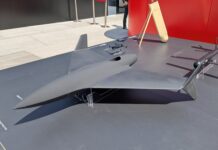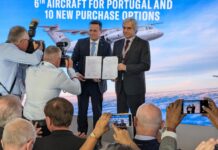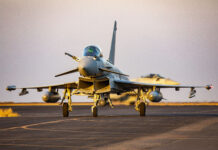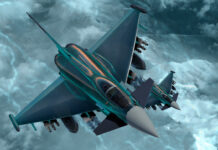In his inaugural Paris Air Show press briefing on 18 June 2025 Eurofighter CEO Jorge Tamarit Degenhardt signalled that the time has come for the Eurofighter to undergo a mid-life update (MLU) programme.
Degenhardt noted that Eurofighter’s current Phase 4 Enhancement (P4E) programme is “really a massive development in terms of radar development, avionics, flight control systems, electronic warfare, weapons integration, and also, and consistently, regulatory requirements”, adding, “I would say this is the biggest phase enhancement we have ever tackled at Eurofighter.”
He added, however, “We need to rethink a bit the way we are delivering and the way we are executing these developments. … We need to go for a mid-life upgrade of the Eurofighter. We’re reaching the limit of the current hardware architecture, and we need to implement new functionalities that will enable the Eurofighter to be operable and interoperable in the future battlefield.
“Normally, we’re always talking about a long-term evolution; this is something that was happening the day after tomorrow,” said Degenhardt, but he added, “We are defining this mid-life upgrade today.
“It’s also important to say that we should switch our mind,” he said. “We’re not talking about a legacy fighter. What we are leaving behind is the adolescence of the Eurofighter. You’re going for a mid-life upgrade; the Eurofighter will be contemporary to the next-generation systems; it will be fighting with the fifth-generation aircraft and with sixth-generation combat systems midlife, no longer a legacy fighter.”
Asked by ESD to what extent the mid-life upgrade is driven by a need to rebaseline the hardware capabilities of the aircraft and to what extent it is a response to a re-evaluation of new concepts of operation that will need to be accommodated, Degenhardt replied, “Reaching the computing capacity is the trigger. The long-term evolution has been in the making for years. What we are seeing as the FCAS [French-German Spanish Future Combat Air System] and GCAP [UK-Italian-Japanese Global Combat Air Programme] programmes mature is that we need to keep an eye on the concept of operation because it will have an impact. We are defining today a hardware architecture that needs to be flying well into the 2060s, so this moment of making a pause and thinking of what we are developing today, the right solution for the future, is something that we are reassessing in kind of a rolling wave.”
Since the programme began Eurofighter has received 729 orders for the aircraft, of which 612 aircraft have been delivered. As well as being operated by the four Eurofighter consortium nations – Germany, Italy, Spain and the United Kingdom – the aircraft is also in service with the air forces of Austria, Kuwait, Qatar, Oman and Saudi Arabia.
Regarding recent and future potential Eurofighter sales, Degenhardt said, “The end of 2024 was thrilling. You saw Spain ordering 25 additional jets through the Halcon II contract, you saw Italy ordering up to 24 jets; we’ll see Germany by the end of this year topping up with 20 additional ones; and we have really active complaints in several regions – Turkey, the Kingdom of Saudi Arabia, Poland, Austria and many other regions.”
Degenhardt conceded, however, that export approval from Germany remains a hurdle for a sale to Turkey, which has expressed an interest in acquiring 40 jets. The previous German government had resisted such a sale, while the current government, which came to power in February 2025, has yet to make a decision on the sale.
With the slew of additional Eurofighter orders gained in 2024 and the prospect of additional orders ahead, Degenhardt noted that Eurofighter is already looking to increase its production rate from the current 14 aircraft per year to a rate of 20 aircraft per year within 36 months and to boost this to 30 aircraft per year in a roughly similar timeframe, depending on orders received.














